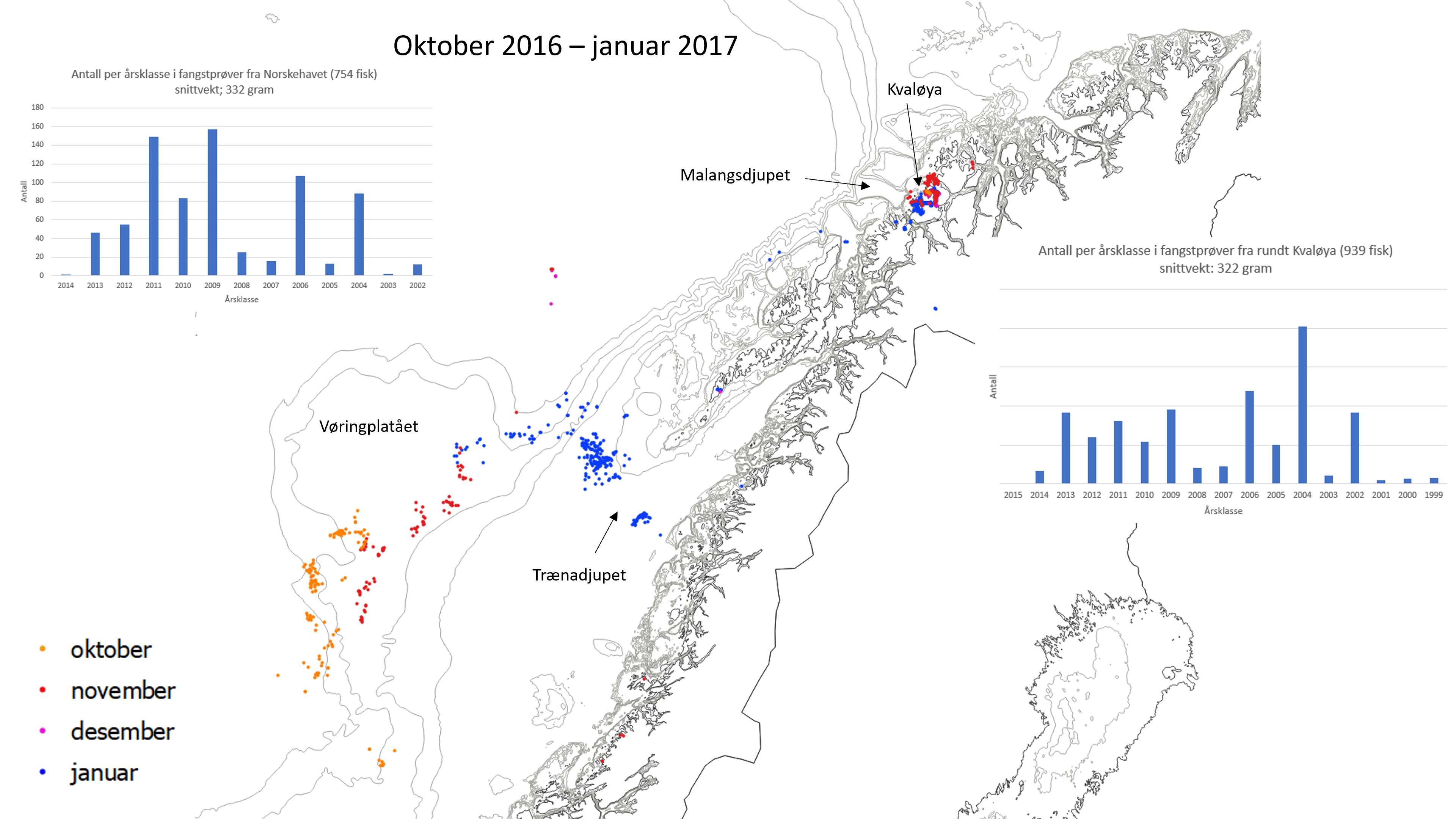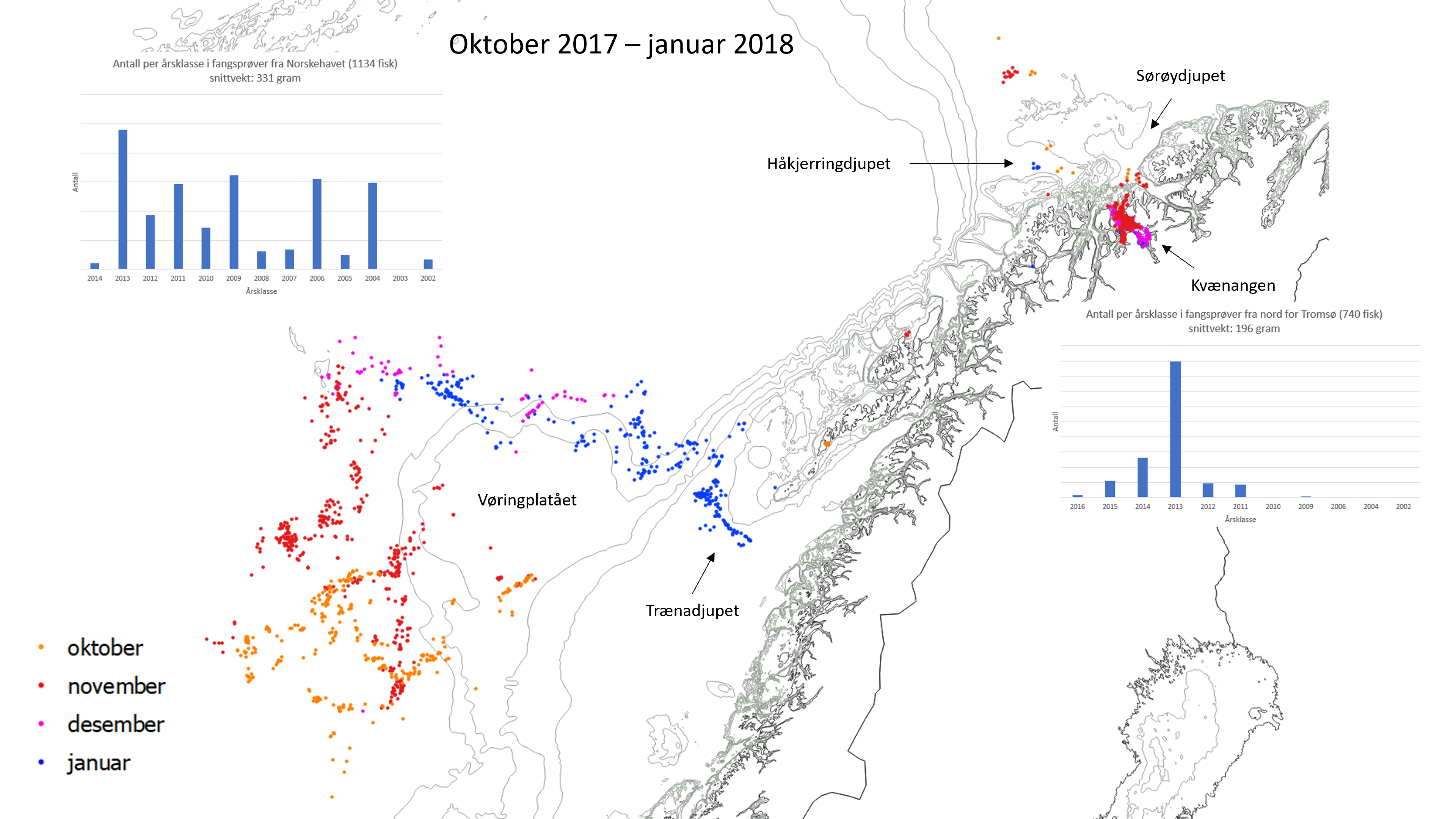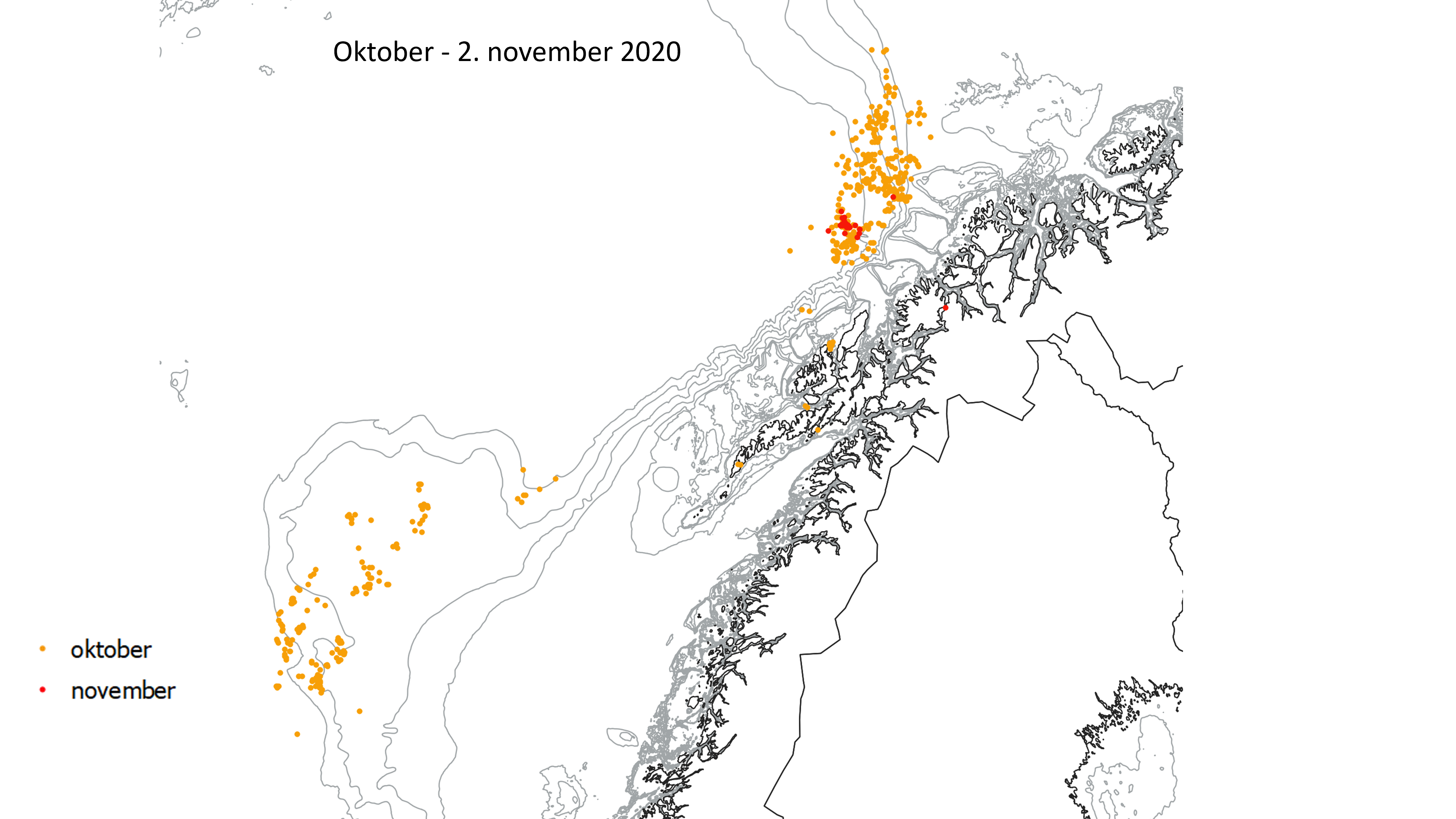Will the herring enter the fjords in northern Norway this winter?

When and where will the herring enter the fjords in northern Norway this winter? Photo from herring fishery outside Senja.
Photo: Aud Vold / IMRPublished: 05.11.2020 Updated: 06.11.2020
We know from historical sources that the phenomenon has been observed far back in time, probably as long as herring has been fished along the Norwegian coast. In the book "The history of Norwegian fisheries", author Trygve Solhaug writes about so-called large herring periods in northern Norway and Trøndelag in the 18th and 19th centuries, with arrival of herring to the coast around Christmas time, which provided the basis for good fishing for several years in a row.
When herring appear close to shore in calm waters, it becomes easily accessible to fishermen. In the old days, herring was almost inaccessible when it was far out to sea, but even today it is of great importance to the smallest vessels when the herring migrates into the fjords.
Unpredictable overwintering
The stock of Norwegian spring-spawning herring (NVG herring) is the world's largest herring stock, and it has been extremely important to Norway's population throughout history. In February–March, it spawns along the coast of Western Norway and north to Vesterålen. The larvae drift with the coastal current north to the Barents Sea and fjords in Troms and Finnmark where they grow up. The really strong year classes always have the huge Barents Sea as nursery area.
When the NVG herring is three to four years old, it migrates from the nursery areas in the north and out into the Norwegian Sea (the area between Iceland, the Faroe Islands, Norway, Jan Mayen and Bjørnøya). Here it feeds during the spring and summer. In the autumn, it gathers to overwinter, but it varies where this happens. It is this unpredictable wintering dynamics that leads to the winter fisheries that come and go.
At the end of the 19th century and in the first half of the 20th century, a lot of NVG herring overwintered east of Iceland, and this provided the basis for a large Norwegian winter fishery here. After the stock collapsed in the late 1960s, it has overwintered in various places along the Norwegian coast and out in the Norwegian Sea. From the mid-1990s to the mid-2000s, much of the NVG herring overwintered in the innermost part of the Vestfjord area, easily accessible to the Norwegian fishing fleet. After this, it disappeared from the West Fjord in the winter and began to overwinter out in the Norwegian Sea.


Developments in recent years
Here we look at what has happened in recent years when it comes to overwintering and winter fishing for NVG herring. Figure 1 shows where Norwegian herring catches were taken, together with age distributions from samples of a selection of these catches (analysed at the IMR) in the winters 2016/2017 and 2017/2018.
The fishing fleet's catches do not give a complete picture of the herring's distribution as one gets on scientific research cruises, but a herring catch at least shows that there was herring in this position at this time. The catches therefore provide good information about the herring's migrations, but where the fishermen choose to fish for herring is determined by several factors in addition to availability, such as proximity to port, size of the fish, weather conditions and so on. It is important to emphasize that there can also be a lot of herring in areas where there is no fishing.
In the winter of 2016/2017, a lot of herring overwintered in the fjords on Kvaløya just west of Tromsø (Figure 1a), similar to previous years. In addition, a lot of herring overwintered far out in the Norwegian Sea west of Lofoten. The age distributions show that both the herring at Kvaløya and out in the Norwegian Sea consisted of both old and young herring.
From the winter of 2016/2017 to the winter of 2017/2018, however, major changes took place that have so often happened before. The herring disappeared from Kvaløya just west of Tromsø, and appeared in a completely different place the following year: in the fjord areas at Kvænangen around 100 km northeast of Tromsø (Figure 1b).
A theory
The age distributions from the catches show that the herring that came into Kvænangen was much younger than the one that overwintered around Kvaløya the year before. It was the relatively strong 2013-year class that dominated in Kvænangen. The herring that overwintered in the Norwegian Sea consisted of many more year classes, but it is worth noting that there was a lot of the 2013-year class here as well. The two following winters, the situation was relatively similar with overwintering young herring in Kvænangen and older herring in the Norwegian Sea.
Why did the herring disappear from Kvaløya and appeared in Kvænangen the following year? There is a theory. IMR scientist Geir Huse and others wrote a scientific paper on the wintering dynamics of NVG herring in 2010. Here they demonstrated that NVG herring changes the wintering area when strong year classes enter the adult population.
They interpret this phenomenon as the so-called numerical domination; the new strong year class "decides" where the rest of the herring swim as they dominate the stock.
This theory seems to agree well with the 2013-year class, which is relatively strong. The theory is that when the 2013-year class entered the adult population around 2017, much of the year class started moving to Kvænangen. Some of the old herring that previously wintered around Kvaløya joined the "drag suction" to Kvænangen and possibly also south to the overwintering areas in the Norwegian Sea in autumn 2017. This situation persisted for the next two winters.

Exciting weeks ahead
And this winter? Based on the fisheries carried out so far this fall (Figure 2), there has been no significant access of herring to the Norwegian coast, to Kvaløya, Kvænangen or other fjord areas. As in recent years, it appears that NVG herring is divided into two wintering areas: one in the Norwegian Sea west of Lofoten, and one in the north, west of Tromsø. There is now again a strong year class recruiting to the adult part of the NVG herring population, namely the 2016-year class.
The average weights in the catch reports and the few age samples that we have so far from the northern area, show that the 2016-year class strongly dominates in these catches. This indicates that this year class will overwinter in or near this area. Given that the 2016-year class now dominates in the northern portion of the population, this year it will probably "determine" the northern wintering areas.
Based on logbook positions similar to Figures 1 and 2, but for several years, it appears as if the herring follow deep trenches on the continental shelfon its way to shore like Malangsdjupet on its way to Kvaløya and Håkjerringdjupet on its way to Kvænangen (possibly also Sørøydjupet).
Herring seems to prefer deep waters where it winters, on deep waters in the open sea and deep fjords. From where the herring is now found north of Andenes, for example, there is a relatively short distance from Malangsdjupet to Kvaløya and not far from Håkjerringdjupet to Kvænangen.
Herring may also appear in the fjords around Senja and Andøya; for example, some catches have already been taken at the entrance to the Gavl fjord between Andøya and Langenes. Therefore, it is still possible for significant amounts of herring to enter one or more fjord areas, but it is not certain. In the period 2007 to 2010, for example, herring stayed in the open sea northwest of Andenes throughout the winter. The next few weeks will be exciting!
